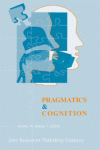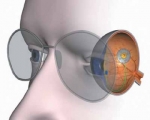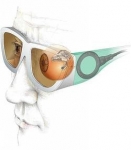Apr 26, 2006
Neural interfaces for gaming
Via VRoot
Mercurynews reports that at least two start-ups have developed technology that monitors a player's brain waves and uses the signals to control the action in games. They hope it will enable game creators to immerse players in imaginary worlds that they can control with their thoughts instead of their hands.
San Jose's NeuroSky has been testing prototypes of its system that uses a sensor-laden headband to monitor brain waves, and then uses the signals to control the interaction in video games. They hope that such games are just the beginning of a mind-machine interface with many different applications.

Read the full story
22:47 Posted in Brain-computer interface | Permalink | Comments (0) | Tags: Positive Technology
Idearium
22:31 | Permalink | Comments (0) | Tags: Positive Technology
Simulator Allows Doctors To Experience Heart Failure
Doctors and nurses who treat heart-failure patients get a chance to feel and experience what heart failure is really like.
Symptoms of heart failure include difficulty breathing, feeling tired, heart palpitations and tightness in the chest.
Doctors and nurses are placed inside Heart FXPod [<http://www.heartfxpod.com/>], created for Astra-Zeneca, which simulates what it is like for their patients.
They use the pedals to walk like a heart-failure patients and use headphones to be trapped in the patient's world
The doctors and nurses are strapped in a pneumatic vest that inflates and suddenly makes it difficult for them to breathe.
It is virtual reality, but it is a little more real than some might like.
"Severe chest tightness. So now I know what my patients go through," said Dr. Siva Srinivasan, of Thomas Jefferson University Hospital.
Srinivason said that after the simulator, he might treat his patients differently.
The Heart FXPod is a multi-sensory interactive simulation that leaves you with no doubt what it's like when your heart fails to provide enough oxygen and blood flow to your body.
If someone trying the pod gets scared they have the ability to stop it.
Dr. Paul Mather directs the Advanced Heart Failure Center at the Jefferson Heart Institute.
"Everyone has sympathy towards other human beings. I think that's part of our human element. But empathy, where you can actually feel what another person is going through as opposed to just feeling sorry for them, is different. I think if we can marry that feeling to the science of medicine, it will make for a better health care provider," Mather said.
Mather said that about 15 years ago, heart failure was a death sentence. Now, doctors can help it regress and patients can often end up living good lives.
15:08 Posted in Cybertherapy | Permalink | Comments (0) | Tags: Positive Technology
Apr 25, 2006
Is technology changing our brains?
From Smart Mobs
Neuro-biologist Susan Greenfield asked this interesting question:
" In just a couple of decades, we have slipped away from a culture based essentially on words to one based essentially on images, or pictures. This is probably one of the great shifts in the story of modern humans but we take it almost for granted.There can be little doubt that the structures, never mind the surface form, of the English language are changing fast.
The process of traditional book-reading, which involves following an author through a series of interconnected steps in a logical fashion. We read other narratives and compare them, and so "build up a conceptual framework that enables us to evaluate further journeys... One might argue that this is the basis of education ... Traditional education, she says, enables us to "turn information into knowledge."
Put like that, it is obvious where her worries lie. The flickering up and flashing away again of multimedia images do not allow those connections , and therefore the context, to build up. ...
23:40 Posted in Persuasive technology | Permalink | Comments (0) | Tags: Positive Technology
Text messaging in psychotherapy
From Smart Mobs
Instant messaging, favored by chatting teens and office gossips, is a growing tool for therapists counseling people on everything from smoking cessation to sexual-abuse trauma, reports the Pioneer Press.
Proponents say the text-based conversations are appealing because they're fast and anonymous — users can log onto a number of online services and connect with therapists who know them only by screen names. But many in the mental-health community say the format is too impersonal for effective treatment and should be only an adjunct to face-to-face counseling.... Text messaging, critics say, doesn't allow therapists to pick up on important visual cues to a patient's true state of mind.
"What one gleans as a psychiatrist in a clinical assessment is not just from the words one says but from the emotions," says Paul Appelbaum, a psychiatry professor at Columbia University and past president of the American Psychiatric Association. He says doctors need to assess the way a person walks, sits, smiles or tears up.
23:38 Posted in Cybertherapy | Permalink | Comments (0) | Tags: Positive Technology
Toward brain correlates of natural behavior: fMRI during violent video games
Toward brain correlates of natural behavior: fMRI during violent video games.
Hum Brain Mapp. 2006 Apr 20;
Authors: Mathiak K, Weber R
Modern video games represent highly advanced virtual reality simulations and often contain virtual violence. In a significant amount of young males, playing video games is a quotidian activity, making it an almost natural behavior. Recordings of brain activation with functional magnetic resonance imaging (fMRI) during gameplay may reflect neuronal correlates of real-life behavior. We recorded 13 experienced gamers (18-26 years; average 14 hrs/week playing) while playing a violent first-person shooter game (a violent computer game played in self-perspective) by means of distortion and dephasing reduced fMRI (3 T; single-shot triple-echo echo-planar imaging [EPI]). Content analysis of the video and sound with 100 ms time resolution achieved relevant behavioral variables. These variables explained significant signal variance across large distributed networks. Occurrence of violent scenes revealed significant neuronal correlates in an event-related design. Activation of dorsal and deactivation of rostral anterior cingulate and amygdala characterized the mid-frontal pattern related to virtual violence. Statistics and effect sizes can be considered large at these areas. Optimized imaging strategies allowed for single-subject and for single-trial analysis with good image quality at basal brain structures. We propose that virtual environments can be used to study neuronal processes involved in semi-naturalistic behavior as determined by content analysis. Importantly, the activation pattern reflects brain-environment interactions rather than stimulus responses as observed in classical experimental designs. We relate our findings to the general discussion on social effects of playing first-person shooter games. Hum. Brain Mapping 2006. (c) 2006 Wiley-Liss, Inc.
23:35 Posted in Cybertherapy | Permalink | Comments (0) | Tags: Positive Technology
VRoot.org -: Neural Interfaces: Scientists Probe the Use of the Tongue
PENSACOLA, Fla. - In their quest to create the super warrior of the future, some military researchers aren't focusing on organs like muscles or hearts. They're looking at tongues. By routing signals from helmet-mounted cameras, sonar and other equipment through the tongue to the brain, they hope to give elite soldiers superhuman senses similar to owls, snakes and fish.
23:27 Posted in Neurotechnology & neuroinformatics | Permalink | Comments (0) | Tags: Positive Technology
Video introducing eyetracking
23:24 Posted in Research tools | Permalink | Comments (0) | Tags: Positive Technology
Transcranial direct current stimulation
From New Scientist
It sounds like quackery, but it's not. A growing body of evidence suggests that passing a small electric current through your head can have a profound effect on the way your brain works. Called transcranial direct current stimulation (tDCS), the technique has already been shown to boost verbal and motor skills and to improve learning and memory in healthy people - making fully-functioning brains work even better. It is also showing promise as a therapy to cure migraine ...
Read the full article
23:20 Posted in Research tools | Permalink | Comments (0) | Tags: Positive Technology
Neuroelectronics
Via Mind Hacks

The New Atlantis has a comprehensive article on 'neuroelectronics' - the science of interfacing digital components with neural wetware. From the article:
The potential merging of mind and machine thrills, frightens, and intrigues us. For decades, experiments at the border between brains and electronics have led to sensationalistic media coverage, vivid science fiction portrayals, and dreams of cyborgs and bionic men. But recently, this area of science has seen remarkable advances—from robotic limbs controlled directly by brain activity, to brain implants that alter the mood of the depressed, to rats steered by remote control. Adam Keiper explores the peculiar history and present directions of this research, and considers the challenges of staying human in the age of neuroelectronics.
23:11 Posted in Neurotechnology & neuroinformatics | Permalink | Comments (0) | Tags: Positive Technology
Takeluma sonic alphabet

[pcho.net & pcho.net (avi, 13mb)]
23:02 Posted in Cyberart | Permalink | Comments (0) | Tags: Positive Technology
Games for Health Day
Davidson Executive Conference Center 3415 South Figueroa Street :: Los Angeles, California 90089
The Games for Health Project, Robert Wood Johnson Foundation, TATRC, and USC’s Annenberg School for Communication & Institute for Creative Technologies invite you to join us on May 9 for a full-day event devoted to the use of games and game technologies in health and healthcare, including an evening reception.
This one-day event, just before the opening of the Electronic Entertainment Expo will bring together researchers, game developers, and health & healthcare professionals for a series of talks devoted to how games and game technologies are addressing critical health & healthcare issues.
Talks will focus on:
• Health messaging using games
• Combat & emergency medicine
• Psychotherapy and Post Traumatic Stress Disorder
• Pain Distraction & Anxiety
• Cancer treatment
• Disease management
• Coping with family ailments
• Cognitive health
• Off-the-Shelf consumer health & exergaming titles
22:57 Posted in Positive Technology events | Permalink | Comments (0) | Tags: Positive Technology
Humanlike robots
Via the Presence Listserv
 Japan boasts the most advanced humanoid robots in the world, represented by Honda's Asimo and other bipedal machines. They are expected to eventually pitch in as the workforce shrinks amid the dwindling and aging population. But why build a robot with pigmented silicone skin, smooth gestures and even makeup? To Repliee's creator, Hiroshi Ishiguro, the answer is simple: "Android science."
Japan boasts the most advanced humanoid robots in the world, represented by Honda's Asimo and other bipedal machines. They are expected to eventually pitch in as the workforce shrinks amid the dwindling and aging population. But why build a robot with pigmented silicone skin, smooth gestures and even makeup? To Repliee's creator, Hiroshi Ishiguro, the answer is simple: "Android science."
Read the full story from Scientific American
22:45 Posted in AI & robotics | Permalink | Comments (0) | Tags: Positive Technology
Apr 22, 2006
Neuromarketing: Brain Fitness Concept Challenged
13:07 Posted in Brain training & cognitive enhancement | Permalink | Comments (0) | Tags: Positive Technology
A website that predicts your thoughts
From Cognitive Daily
There is a website that claims to predict with 98 percent accuracy what site visitors would be thinking after a short quiz.
I tried the game and it worked!
Then I looked for other mind-readers, and I found several versions:
there is even a website that offers different Flash-based customizations of the mind reader
12:47 Posted in Cyberart | Permalink | Comments (0) | Tags: Positive Technology
Apr 21, 2006
The mood of your blog
Via Smart Mobs (New Scientist)
New Scientist has an article about a software called MoodViews that tracks mood swings across the 'blogosphere' and pinpoints the events behind them. Moodviews was created by Gilad Mishne and colleagues at Amsterdam University, The Netherlands. At present, MoodViews consists of three components, each offering a different view of global mood levels, the aggregate across all postings of the various moods:
- Moodgrapher tracks the global mood levels,
- Moodteller predicts them, and
- Moodsignals helps in understanding the underlying reasons for mood changes.

From the MoodViews website:
"Check out the impact of global events on global moods. Find out whether it is true that people drink more during the weekend. Observe states-of-mind with a cyclic nature; e.g., people feel energetic in the mornings and relaxed in the evening"
19:10 Posted in Emotional computing | Permalink | Comments (0) | Tags: Positive Technology
Workshop on the Cognitive Science of Games and Game play
As part of CogSci 2006, 26-29 July 2006, Montreal, Canada
From the website
Craig Lindley: Cognitive Science of Games and Gameplay (full day)
Cognitive science has always had a strong relationship with games and game play. Simple cognition tests frequently having the form of games, and games like chess have provided traditional models of intense cognitive challenges. Ongoing advances in computer game technology have supported the creation of commercial games presenting a wide variety of cognitive challenges embedded within rich, engaging audiovisual worlds. The growth of computer games as an entertainment technology and medium is having a major cultural and social impact, with game players frequently spending large portions of their discretional time deeply immersed in game play.
Despite the emergence of computer games as a major cultural and economic force, the scientific study of complex games is in its very early stages. Methodologies and theoretical paradigms are still being established, and the world waits for substantial results before game systems can be more fully deployed across broad application areas. Games are fundamentally learning systems and this is of particular interest, both from the perspective of the cognitive changes in players arising from entertainment gameplay (and their attendant social implications) and from the perspective of how games might function in more specific pedagogical and therapeutic contexts.
Theories and methods from cognitive science appear to be among the most promising for studying the structure, dynamics, affects and effects of games and game play. Moreover, computer games provide rich, multi-modal, but still controllable environments for conducting cognitive experiments having potentially higher ecological validity than the rarefied experiments of traditional cognitive psychology.
This workshop aims to bring together cognitive scientists interested in game phenomena, cognitive scientists interested in using games as a research tool, game researchers interested in cognitive approaches to the study of games, and game researchers interested in games for the study of cognition. The aim is to consolidate and focus these interests in a new field of the Cognitive Science of Games and Game Play. Topics of interest include but are not limited to:
- cognition-based theoretical frameworks for the study of games and gameplay
- games as a methodological tool for cognition research
- emotion and aesthetics of games and game engagement
- cognitive neurophysiology of games and play
- cognitive foundations of game design principles
- cognitive and perceptual substructure of game interaction
- effects of game play upon player cognitive processes
- schemata involved in game play
- player modelling and motivational factors
- computational modelling of players, play processes, tactics, strategies and learning
- game interaction as a basis of cognitive modelling
- perceptual loading, attention and cognitive capacity management in game play
- empirical study of games, methods, results and interpretations
- social cognition and multiplayer games
- the cognitive substructure of fun
The workshop will be held from 0830 to 1700 on Wednesday July 26 2006.
Submission
Those interested in attending the workshop should submit a 500 – 1000 word abstract by 19 May 2006. Submissions should be sent in electronic form to: craig.lindley@hgo.se Authors of accepted abstracts should submit full papers by Friday 30 June 2006. Full papers may be up to 10 A4 pages in length.
19:00 Posted in Call for papers | Permalink | Comments (0) | Tags: Positive Technology
Electronic media causing ADHD?
From Mind Hacks
Neuroscientist Baroness Greenfield was featured on Radio 4's Today Programme this morning [realaudio] arguing that children are being medicated for ADHD when the problem might be caused by the over-use of 'electronic media' leading to short attention spans...
read the full post
18:05 Posted in Persuasive technology | Permalink | Comments (0) | Tags: Positive Technology
Ageing, Impairment, and Technology
Forthcoming special issues of Pragmatics & Cognition

Editors: Pim Haselager, Maria Eunice Qumlice Gonzales, and Itiel Dror
Deadline for submissions: 30 June 2006
Publication: Summer 2007
2. Ageing, Impairment, and Technology (call for papers)
Editors: Romola Bucks, Jonathan Cole, and Itiel Dror
Deadline for submissions: 30 June 2007
Publication: Summer 2008
Editors: Boris Velichkovsky and Itiel Dror
Deadline for submissions: 30 June 2008
Publication: Summer 2009
6. Cognitive Development and Education in the Mirror of Technology (call for papers)
Editors: TBA and Itiel Dror
Deadline for submissions: 30 June 2009
Publication: Summer 2010
16:25 Posted in Call for papers | Permalink | Comments (0) | Tags: Positive Technology
Intelligent Medical Implants Reports Artificial Vision Breakthrough
"The provoked visual perceptions were pleasant, according to the patients, and this was the first time they had seen something in many years-- in one case, several decades. Understandably, they reacted emotionally to their visual experience."
Hans-Juergen Tiedtke
Chief Executive Officer
IIP-Technologies GmbH
IIP-Technologies GmbH, on behalf of its parent company Intelligent Medical Implants AG ("IMI") (www.intmedimplants.com), announced today that a limited clinical study related to its ongoing Early Human Trial has demonstrated that IMI's patented, first-generation Learning Retinal Implant(TM) enabled patients to see light - as well as simple patterns - via a wireless transmission of data and energy. This is the first time in the history of the development of artificial vision that completely wireless transmission of data and energy into an implant in the eye of long-time blind persons has resulted in pattern recognition.
 The Learning Retinal Implant has been successfully implanted in four patients for a duration of up to 13 weeks to date (the first implantation occurred in late-November 2005). Subsequent clinical testing of the IMI device with these patients commenced on schedule beginning in January 2006 at the University of Hamburg (Germany) Medical School under principal investigator Prof. Gisbert Richard, Professor of Ophthalmology. Each of the implantations has been "extremely well-tolerated" and fixation of the implant has been "stable, with no inflammatory reactions," according to Prof. Richard.
The Learning Retinal Implant has been successfully implanted in four patients for a duration of up to 13 weeks to date (the first implantation occurred in late-November 2005). Subsequent clinical testing of the IMI device with these patients commenced on schedule beginning in January 2006 at the University of Hamburg (Germany) Medical School under principal investigator Prof. Gisbert Richard, Professor of Ophthalmology. Each of the implantations has been "extremely well-tolerated" and fixation of the implant has been "stable, with no inflammatory reactions," according to Prof. Richard.
"Each of these blind persons had no visual perception at all, yet upon wireless stimulation of the retina via the Learning Retinal Implant, they were able to 'see' something,"said Hans-Juergen Tiedtke, CEO of IIP-Technologies, a subsidiary of IMI. "One patient, for example, a 65-year-old female from Marienberg, Germany, has not had sight for more than a half century. From early childhood she has suffered from RP, meaning that she has not seen normally for more than 60 years. Nevertheless, in her first pattern recognition test, she described continuous objects such as a half circle. There is no doubt that this result is extremely positive, given that she has had no sight for almost her entire life, yet was still able to immediately receive a visual perception from electrical stimulation.

"While further clinical testing is needed and planned, we are truly delighted by these early results. It is our expectation that, in the not-too-distant future, our Learning Retinal Implant System, along with rehabilitation, may allow patients to recognize objects by identifying their size, as well as their position, movements and shapes. In other words, a blind person, using our Learning Retinal Implant System, is expected to be able to move independently in an unfamiliar environment--thus enabling him or her to lead an autonomous life. Indeed, development of a wireless visual prosthesis that could be implanted permanently with good results is the 'Holy Grail' of artificial vision," added Mr. Tiedtke.
IMI's initial clinical-indication focus is blind persons with Retinitis Pigmentosa ('RP'), one of the two most common causes of vision loss in persons over the age of 50 by hereditary degenerative retinal diseases. RP is considered irreversible, and no treatment or cure is known to date. Several million people are affected worldwide.
13:30 Posted in Brain training & cognitive enhancement | Permalink | Comments (0) | Tags: Positive Technology







